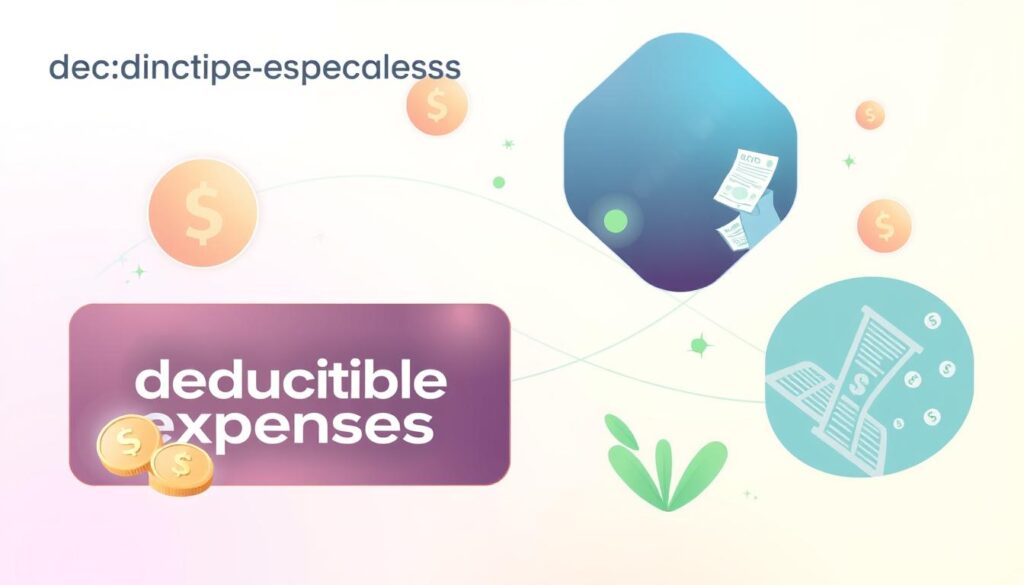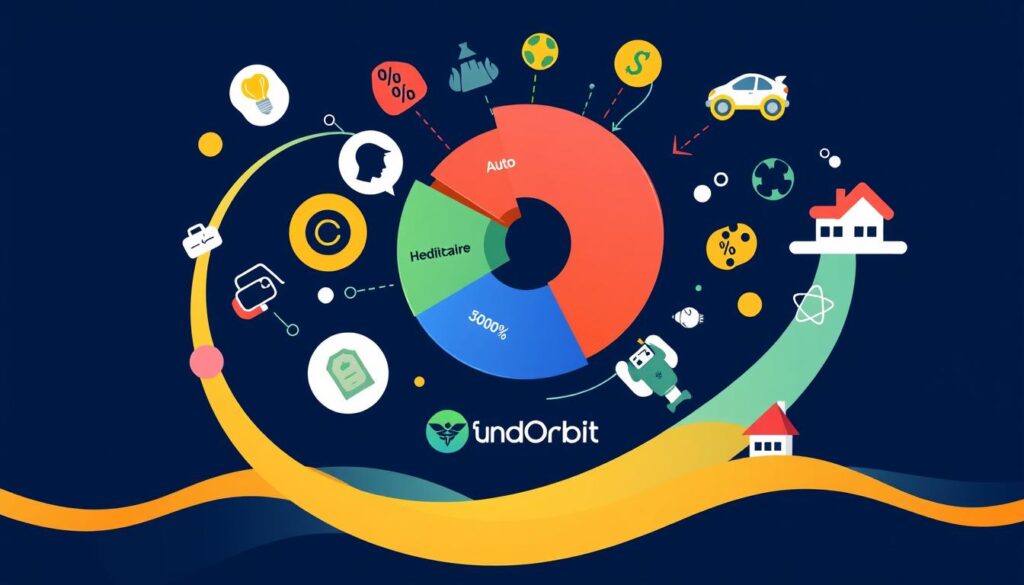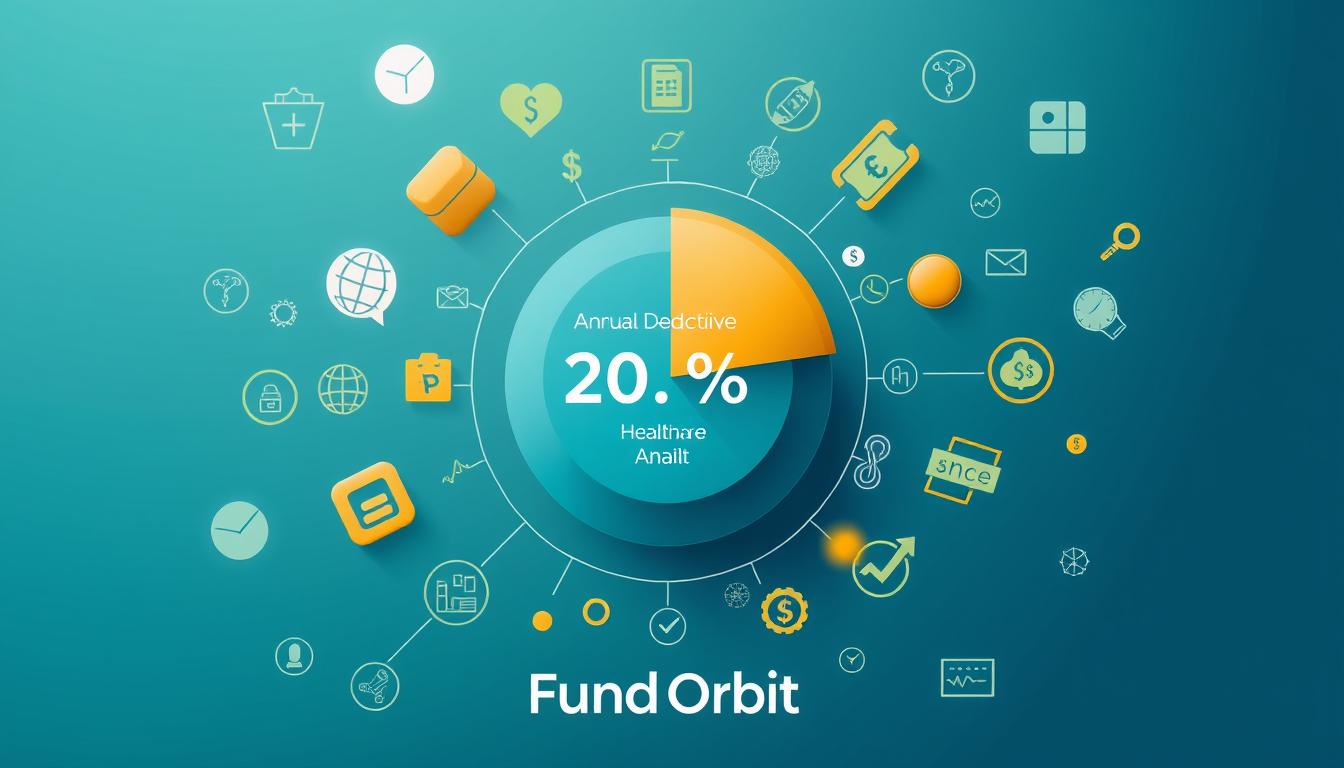Understanding deductibles is key, whether it’s for life, auto, or health insurance. Deductibles are a big part of insurance policies. Knowing how they work helps us make smart choices when buying insurance and filing claims. The deductible percentage is important in setting the annual deductible. This amount can change a lot based on the insurance type and policy.
It’s important to know about different deductibles, like annual and percentage deductibles. This knowledge helps us choose better insurance and manage our costs. For example, health insurance in the U.S. often has a $1,500 deductible for individuals. Family deductibles can be much higher, averaging $10,310 in 2024.
Key Takeaways
- Understanding deductibles is key for smart insurance choices.
- A deductible percentage can greatly affect your annual deductible and costs.
- Health insurance deductibles vary, with an average of $1,500 for individuals and $10,310 for families in 2024.
- High deductible plans might have lower monthly costs but could mean more for medical expenses.
- Knowing about annual and percentage deductibles is important for picking the right policy.
- It’s vital to review and understand your policy’s terms, including the deductible, for good insurance planning.
- Using resources like privacy policies can give insights into insurance and deductibles.
What is an Annual Deductible?
It’s important to know what a deductible is in health insurance. A deductible is the amount you pay before your insurance covers expenses. We’ll look at the different types of deductibles and why they matter.
The deductible amount varies by policy. For example, if your deductible is $1,000, you pay the first $1,000 of medical costs. Then, your insurance kicks in. This can greatly affect how much you spend on healthcare.
Definition and Importance
Understanding deductibles is key in health insurance. There are different types, like dollar amounts and percentages. Knowing these can help you pick the right policy.
Types of Deductibles
There are many deductible types, like HDHPs and low deductible plans. HDHPs have lower monthly costs but higher upfront costs. Low deductible plans have higher monthly costs but lower deductibles, covering expenses sooner. Knowing these options helps you choose wisely.
In summary, knowing about deductibles is essential for health insurance choices. By understanding the different types and their effects, you can find the best policy for your budget and needs.
How Is the Percentage of a Deductible Calculated?
The deductible calculation is key in insurance policies. It shows how much you must pay before insurance helps. The amount can change based on the policy type, coverage level, and more. For example, deductibles in homeowners and auto insurance often start at $500 to $1,000.
Several factors influence deductible calculation. These include the insurance type, coverage level, and policy terms. For example, a $100,000 house with a 2% deductible means a $2,000 deductible for a $10,000 claim. This shows why knowing about deductibles is important.
Insurance policies have different deductible types. Some are percentage-based, while others are fixed. For instance, homeowners insurance deductibles can be 1% to 5%. Higher percentages are used in areas prone to hurricanes and wind/hail damage. Knowing these details helps policyholders choose the right coverage.
- A $200,000 home with a 2% deductible means a $4,000 deductible for a $30,000 claim.
- A car insurance policy with a $500 deductible means you pay $500 before insurance covers you.
Understanding deductible calculation helps policyholders make smart choices. It ensures they’re well-protected against unexpected events.
Why Do Annual Deductibles Matter?
Knowing your insurance deductible is key because it affects how much you pay out of pocket. When looking at deductible insurance, think about how it fits into your budget. Deductibles usually range from $500 to $1,000, which changes your insurance costs.
Higher deductibles mean lower premiums. This is because higher deductibles lead to fewer claims. This helps insurance companies stay afloat. Here are some examples:
- Homeowners insurance deductibles are a percentage of your home’s value.
- Hurricane damages have a separate deductible, usually a percentage of your home’s value.
Also, most deductibles don’t apply to bodily injury liability payments. Claims under the deductible amount aren’t covered. So, picking a deductible that fits your budget is key. This way, you get the best coverage for your money.

In summary, deductibles are vital for healthcare budgeting. They directly influence your costs and premiums. By understanding deductible expenses, you can choose the right deductible insurance. This ensures you get the best value for your healthcare coverage.
| Deductible Type | Description |
|---|---|
| Fixed Deductible | A specific dollar amount, such as $1,000 for a homeowner’s insurance policy. |
| Percentage Deductible | A percentage of the insured value, such as 2% on a home insured for $300,000. |
How Annual Deductibles Differ by Insurance Plan
Understanding deductibles is key. They change based on the insurance plan you choose. The type of plan and coverage level affect the deductible amount. It’s important to compare different plans.
Here’s how deductibles vary in 2024:
- HMO: $1,484
- PPO: $1,252
- POS: $2,094
- High deductible health plan (HDHP): $2,666
Deductible structures differ, impacting coverage and costs. This highlights the importance of understanding various insurance plans.
For example, high-deductible plans with savings options have a $2,424 average deductible. The average annual premium for single coverage is $7,016. Non-high-deductible plans have a $1,294 average deductible and a $8,023 average premium.

Knowing these differences helps in making smart healthcare choices. By grasping the deductible definition and meaning in different plans, you can better manage healthcare costs. This way, you can pick a plan that fits your needs.
Common Misconceptions About Deductibles
We often hear wrong ideas about deductibles that cause confusion. It’s key to know the truth about deductible types and their role. Deductibles help share the risk between you and your insurer. Knowing this is vital for smart insurance choices.
Many think all deductibles are the same. But, different deductible expenses apply to various insurance policies. For example, hurricane deductibles can be a flat fee or a percentage of your home’s value. It’s important to know your policy’s deductible to avoid surprises when you file a claim.

- Deductibles may be applied per claim, and multiple claims may require paying the deductible amount for each claim.
- Choosing a higher deductible can lower your premiums, but this effect varies by company and policy.
- Deductibles can differ for different claims, like collision and comp claims under one physical damage coverage.
By knowing the truth about deductibles and deductible expenses, we can make better insurance choices. This helps us avoid common mistakes that could cost us money.
How to Choose the Right Deductible for You
Choosing the right deductible is key when picking an insurance policy. It depends on your personal situation and finances. A higher deductible means lower premiums but more risk for you. A lower deductible offers more protection but costs more each month.
To decide, think about what you need and how much risk you can handle. This helps find a balance between saving money and feeling secure.
A deductible amount that’s too high can be tough on your wallet if you need to make a claim. But, a lower deductible might mean higher insurance costs. It’s important to think about what’s affordable for you and your financial situation.
When picking a deductible, think about your health needs, money situation, and how much risk you’re okay with. Choosing the right deductible means picking one that fits your life and budget.
Some important things to think about when picking a deductible include:
- Your financial situation and ability to pay out-of-pocket expenses
- Your claim history and the likelihood of filing a claim
- The savings from a higher deductible versus the increased risk

By carefully looking at these points and thinking about your own situation, you can choose the best deductible for you. This way, you get the protection you need without breaking the bank.
The Relationship Between Premiums and Deductibles
Understanding how premiums and deductibles work together is key. Generally, the bigger the deductible, the less we pay in premiums. This balance helps us manage our costs and find the best deductible for us.
Choosing between a low-deductible plan with higher premiums and a high-deductible plan with lower premiums depends on our situation. If we use our insurance a lot or have little emergency money, a low-deductible plan might be better. But, if we have savings and don’t use insurance often, a high-deductible plan could save us money.

Here are some important things to think about when looking at premiums and deductibles:
- Higher premiums with lower deductibles are good for those who use insurance a lot.
- High-deductible plans have lower monthly costs than plans with lower deductibles.
- Preventive care is usually covered fully under a high-deductible plan before the deductible is met.
Finding the right mix of premiums and deductibles takes thought about our needs and money situation. By understanding how these two factors work together, we can choose the best deductible insurance. This ensures we have the right coverage without breaking the bank.
| Premiums | Deductibles | Benefits |
|---|---|---|
| Higher | Lower | More predictable budgeting, financial relief for frequent medical care |
| Lower | Higher | Lower monthly premiums, more savings |
What Happens When You Meet Your Deductible?
When you meet your deductible, your health plan starts to cover a part of certain healthcare services. It’s important to know what deductible means and how it works. After you meet the deductible, you’ll pay a co-insurance rate for services. This rate is a percentage of the service’s cost.
For instance, if your deductible is $2,000 and the co-insurance rate is 20%, you’ll pay $200 for a $1,000 service. Your insurance will cover the rest, $800. Keeping track of your expenses is key to getting the most from your insurance.
Some services, like preventive care, are covered fully after the deductible. But, other services might need co-payments or co-insurance. It’s vital to check your insurance plan to know what’s covered and what you’ll pay. Knowing your deductible helps you make smart healthcare choices and get the best coverage.
Here are some important things to remember after meeting your deductible:
- Co-insurance rates apply to most services
- Co-payments may be required for certain services
- Preventive care is often covered at 100%
- Track your expenses to ensure you receive full benefits
Understanding what happens when you meet your deductible helps you manage healthcare costs. It lets you make informed choices about your insurance.
Annual Out-of-Pocket Maximums vs. Deductibles
Many people get confused between annual out-of-pocket maximums and deductibles. It’s important to know the difference to manage healthcare costs. Deductible types and expenses are key when picking a health insurance plan.
The deductible is what we pay before our insurance covers costs. The out-of-pocket maximum is the total we pay for healthcare, including deductibles, copays, and coinsurance. For instance, if our deductible is $1,000 and the maximum is $4,300, we pay $1,000 first. Then, we keep paying until we hit the $4,300 limit.
Key Differences Explained
The big difference is that deductibles only apply to covered expenses. We only pay deductibles for services our insurance covers. Out-of-pocket maximums, on the other hand, include all healthcare costs, including copays, coinsurance, and deductibles.
How They Work Together
Here’s how deductibles and out-of-pocket maximums work together:
- Deductible: $1,000
- Out-of-pocket maximum: $4,300
- Copays: $20 per doctor visit
- Coinsurance: 20% of total bill after deductible is met
In this example, we pay $1,000 before our insurance kicks in. After that, we pay 20% of the bill, and our insurance pays 80%. We keep paying until we hit the $4,300 maximum. Then, our insurance covers 100% of costs.
Knowing the difference between out-of-pocket maximums and deductibles helps us make better choices. It helps us pick the right insurance plan for our needs.
| Deductible | Out-of-pocket Maximum |
|---|---|
| $1,000 | $4,300 |
| $1,600 (HDHP) | $9,450 (individual) |
Tips for Managing Your Deductible
Managing your deductible well needs planning and strategy. It’s smart to make a health budget to track your costs. This helps you plan for any unexpected expenses and stay ready for your deductible.
Understanding how your deductible is calculated is key. It’s about adding up all your healthcare costs. Then, you figure out how much you’ll pay before your insurance starts. Knowing this helps you use your insurance wisely.
Using Health Savings Accounts (HSAs) can also help with your deductible. HSAs let you save money for medical bills before taxes. Here are some tips for using HSAs well:
- Put money into your HSA often to grow your savings
- Use your HSA for medical bills like doctor visits and meds
- Keep an eye on your HSA balance and change your contributions if needed
By following these tips and knowing about deductible calculations, you can handle your deductible better. Always check your policy and talk to your insurance company. This way, you can get the most from your benefits.
| Deductible Type | Description |
|---|---|
| High-Deductible Health Plan (HDHP) | A plan with a higher deductible amount and lower monthly premiums |
| Low-Deductible Plan | A plan with a lower deductible amount and higher monthly premiums |
Conclusion: Planning for Your Annual Deductible
Understanding your deductible definition and deductible meaning is key for good insurance planning. It helps us make smart choices that fit our health needs and budgets. Knowing how your deductible works lets us plan better.
In the United States, we see the value of deductibles in healthcare, just like the Netherlands, Switzerland, and Germany. They use deductibles to help people manage their health costs. For example, Switzerland has a 10% deductible for everyone.
We suggest you check your insurance policy and learn about your deductible. Look for ways to improve your coverage and save money. Using health savings accounts and making a health budget can help. This way, we can all improve our financial health and feel more secure about our healthcare.


